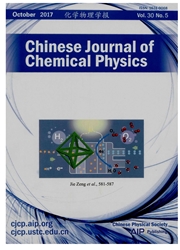

 中文摘要:
中文摘要:
采用B3LYP/6—311++G(d,p)和MP2/6—311++G(d,p)理论方法研究了CH3+Br—YfY=H,CcH,CN,NC)缺电子体系中Br参与的反向卤键(IXB)结构.四个IXB复合物中,MP2/6—311++G(d,p)水平上考虑了基组叠加误差的分子间相互作用能分别为218.87,219.48,159.18和143.05kJ/mol,相对稳定性的递增顺序CH3+..BrCN〈CH3+..BrNC〈CH3+..BrH≈CH3+..BrCCH.自然键轨道分析和相关原子化学位移计算表明形成IXB结构时,电子的流向是从Br—Y到CH3+,采用分了中原予理论方法计算九xBs键鞍点处的电了密度拓扑性质,结果表明CH3+…Br—Y(Y=H,CCH,CN,NC)缺电子体系中的IxBs结构具有较多的供价成分.
 英文摘要:
英文摘要:
Inverse halogen bonds interactions involving Br in the electronic deficiency systems of CH3+...Br-Y (Y=H, CCH, CN, NC) have been investigated by B3LYP/6- 311++G(d, p) and MP2/6-311++G(d, p) methods. The calculated interaction energies with basis set super-position error correction of the four IXBs complexes are 218.87, 219.48, 159.18, and 143.05kJ/mol (MP2/6-311++G(d, p)), respectively. The relative stabilities of the four complexes increased in the order: CH3+ … BrCN〈CH3+…- BrNC〈CH3+… BrH≈CH3+ …BrCCH. Natural bond orbital theory analysis and the chemical shifts calculation of the related atoms revealed that the charges flow from Br-Y to CH3e. Here, the Br of Br-Y acts as both a halogen bond donor and an electron donor. Therefore, compared with conventional halogen bonds, the IXBs complexes formed between Br-Y and CH3+. Atoms-in-molecules theory has been used to investigate the topological properties of the critical points of the four IXBs structures which have more covalent content.
 同期刊论文项目
同期刊论文项目
 同项目期刊论文
同项目期刊论文
 Synthesis and Photovoltaic Properties of Alternating Conjugated Polymers Derived from Thiophene-Benz
Synthesis and Photovoltaic Properties of Alternating Conjugated Polymers Derived from Thiophene-Benz 期刊信息
期刊信息
